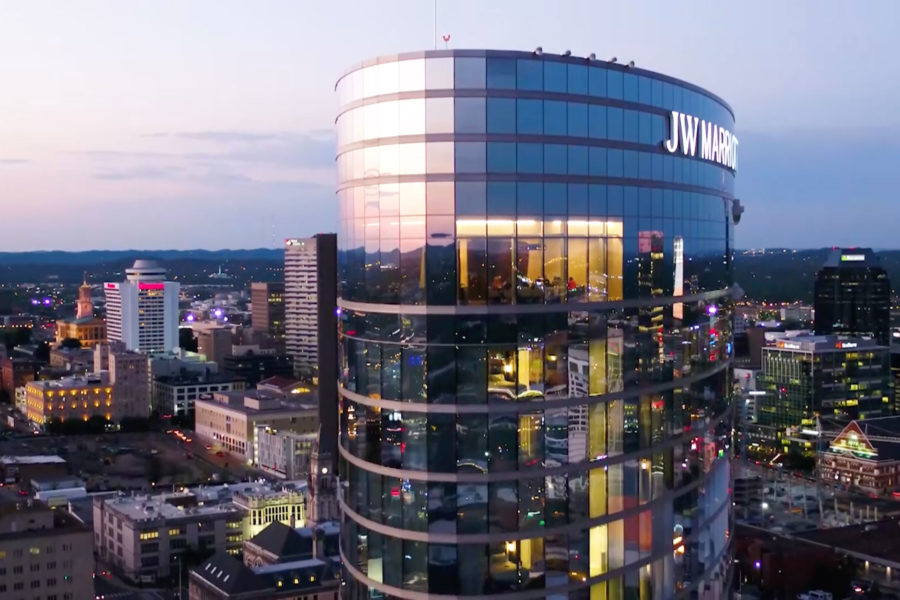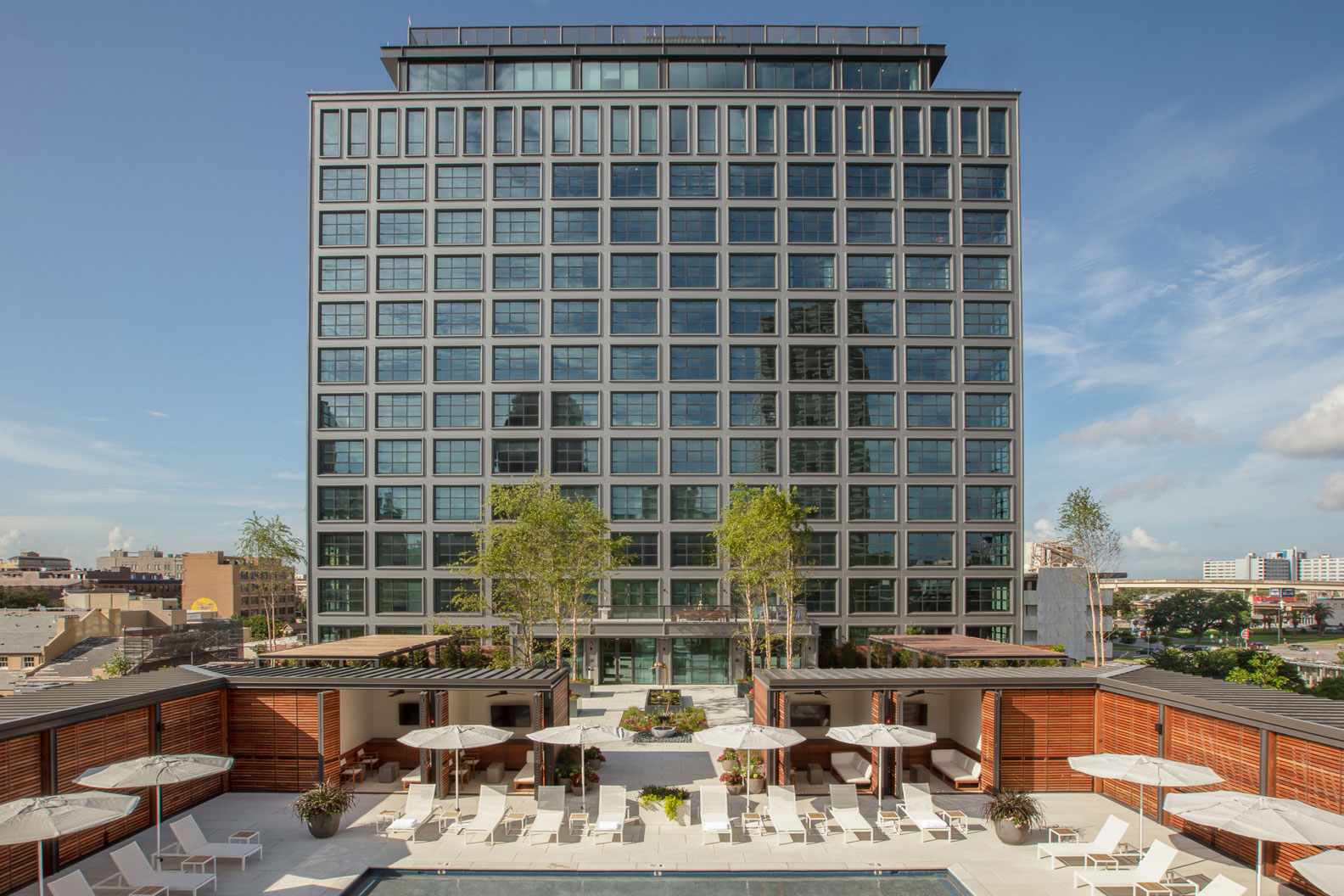According to the Department of Energy, daylighting is a key building strategy that can save money for businesses. It reduces the need for artificial lighting, lessens electricity costs, and creates a more sustainable building. Studies also show that with proper daylighting, productivity at the office goes up and absenteeism goes down.
Several factors contribute to creating the right daylighting—the type of window, window placement, and interior design all control how sunlight comes into a building. One of the most important decisions hinges on the right facade solution for your building.
Window Wall vs. Curtain Wall

JW Marriott Nashville. Photo courtesy of YKK AP
While curtain wall tends to be the first facade solution to be considered for high-rise applications, window wall offers many advantages in today’s market, in which quick installation and cost advantage are critical.
While commercial buildings have traditionally been built with curtain wall, more recently window wall has emerged as a preferred system for mixed-use buildings like offices and hotels. Yet there are differences we should all know about when determining whether to specify a curtain wall vs. window wall system.
Curtain wall systems are designed to sit in front of the building and anchor to each floor line. By definition, window wall systems rest inside the building and span floor-to-floor (or less than one floor). This creates a cost advantage over curtain wall systems, as structural requirements can be met with less material and reinforcing.
A key attribute of window wall systems is the ability to install and glaze from inside the building. This attribute is enhanced by the recent trend of pre-glazing, which further shortens installation time and requires less labor.
When looking at installation, Bart Harrington, field technical services manager at YKK AP America, says the installation of window wall products is akin to that of a storefront versus a curtain wall system. Additionally, more glazing contractors are capable of installing multi-floor window walls, which can create a cost advantage.
“This opens up competition to a wide variety of glazing contractors and the competition can help keep costs down,” Harrington says. “The more sophisticated a project, the fewer the contractors that are able to bid it.”
When you first think of window wall vs. curtain wall, it’s easy to question whether the same clean look of curtain wall can be achieved with window wall. Today innovative slab edge covers exist for this reason, enabling window wall systems to provide a sleek, modern aesthetic and maximum design versatility. Paired with these slab edge covers, window wall mirrors the look of curtain wall from a building’s exterior, while providing high thermal and acoustical performance—at a more reasonable cost.
Acoustical Considerations

The Standard New Orleans. Photo courtesy of YKK AP
Acoustic performance has become an increasingly relevant consideration in the construction market as the population grows, urbanization continues, and ongoing research makes connections between noise exposure and human health. The EPA reports environmental noise pollution negatively impacts millions of people and leads to problems like “stress related illnesses, high blood pressure, speech interference, hearing loss, sleep disruption, and lost productivity.”
This has become even more crucial as prime downtown locations become scarcer and developers look to build on less desirable sites near freeways, airports, and more. This fuels the need for better acoustical performance, as well as the need for better research and understanding of how to achieve better sound control without dramatic cost increases.
While many aspects of interior spaces can make an environment comfortable, including sound-absorbing surfaces and interior partitions, exterior facades are key. In order to obtain the desired level of acoustic performance, it is important to consider the type of glass and fenestration used on a building.
Unlike curtain wall, window wall is a slab-to-slab application. This means the window wall stops at each floor. As a result, it does not transmit sound waves from floor-to-floor, creating better sound attenuation. This provides specifiers with more control over acoustical performance, particularly in mid-to-high-rise residential and multifamily applications where acoustics are highly valued.
The Standard New Orleans, a luxury condominium building, is a great example. Acoustics were a critical factor in defining comfort for its occupants. Because one side of the building faces a higher level of outside noise than the other, each side has a different OITC rating. As a result, a higher level of fenestration was needed for the side with the higher OITC rating. Given the city’s coastal location and the need for strong sound attenuation, a hurricane-impact window wall was leveraged for this reason. Because the system stops at each floor, it eliminates the transmission of sound waves from floor to floor. The system itself has an STC rating of 39, which is about three points better than a typical non-impact window wall.
Pre-Glazed Options for Quick Installation
In today’s fast-paced construction environment where labor continues to be challenging, it’s important to examine pre-glazed options for window wall. This enables all panels to be fabricated, assembled, and glazed in the shop rather than onsite. This also allows for the installation of the system from the inside of the building—a critical specification in spaces where construction sites are tight, and space is limited. A pre-glazed system speeds up the installation process and improves the safety of the installation team by not requiring it to do as much work from the outside of the building. Additionally, window wall shortens the construction cycle by allowing drying-in by floor unlike curtain wall, which requires drying-in by elevation.
Forward-Thinking Designs

Photo courtesy of YKK AP
In the heart of Nashville, the JW Marriott Nashville is a 33-story curvilinear glass tower. While the systems were designed with innovation, performance, and economics in mind, what looks like a simple, straightforward design was quite complex.
John McGill, manager of the project center at YKK AP America recalls the initial stages of the project. “The overall shape and configuration of the building, and the sheer size and scope of it were some of the things that truly set it apart. How to be able to design a system that would accommodate the large scope and still be done in an economical manner, while providing for easy installation from the inside of the building, these were all very challenging aspects to the project.”
While examining the design, engineers identified a total of 25 angles to create the desired elliptical shape with a continuously changing radius. Rather than using a curtain wall, which was originally specified in the design, the team turned to a window wall system. Window wall systems are specifically designed with anchoring flexibility so they can react to challenging wall conditions. Curtain wall isn’t as adaptable.
The result achieved the same look and feel as curtain wall, at a more reasonable price point.
What’s Next for Window Wall
Window wall systems have made a lasting impact in the market. And while sustainability has always been a core aspect to these systems, in 2022, we are likely to see framing manufacturers offer more advanced framing with extra thermal performance to meet and exceed codes and to save energy, without the need for advanced glazing.


